|
 Secure Site
Secure Site
|
 |
Archive for the 'Meditation Tools' Category
 walking in waves, a mindfulness meditation There is nothing more soul-renewing than a very long, meandering, aimless walk. And I do mean aimless — as in, “I’m heading out! I have no idea how long I’ll be or where I’m going!”
I started walking this way quite by accident, in the midst of recovering from the heartache and confusion of losing my job. I had been slothful through winter, alternating between insomnia and sleeps so deep I wasn’t sure what day it was when I woke. But with the changing light of spring, I was beckoned out of doors.
Finding Peace Amidst the Chaos
I was in Manhattan, and cities are excellent places for meditative walks. They’re full of interruptions and distractions, but there is always a bus stop or a person with directions within easy distance. So you can suspend the anxiety about getting lost or getting home.
And all that noise does for humans what shape does for bats: Even if we aren’t tuning into it, it guides our steps and signals danger or direction.
A city walk also delivers the pleasure of unexpected architectural discoveries: trolls clinging to the corners of buildings, swags of flowers carved into stone friezes.
These days I’m walking in the country, in coastal Rhode Island, where the blackbirds and foxes keep me company.
“Exploring the world is one of the best ways of exploring the mind,” writes Rebecca Solnit in “Wanderlust: A History of Walking.” The mind eventually begins to follow the feet, and a logjam of anxiety starts to come loose.
 Soul-Renewing Walking Meditation From Type A to Point Be
Long walks are the cure for writer’s block, lover’s block, mother’s block, friendship block, and any other kind of obstacle that we try to deliberately gnaw our way through, worrying over the problem and getting nowhere.
Better to let yourself really go nowhere and experience the delicious paradox of losing yourself to find yourself.
Walking with indirection has, at heart, a paradoxical benefit. When you stop making decisions for a little while, before you know it, you are filled with purpose, and the goals and paths of your life take on a new clarity.
It is by such grace that life unfolds; how lovely to suspend disbelief (I will never feel good again) and arrive at conviction: Life is wonderful! What a joy to be moving!
How-To: Walking as Meditation
1. Focus on your breathing. Paul Smith, walking-meditation instructor at Lake Austin Spa Resort in Austin, Texas, recommends inhaling slowly through your nose for 4 steps, keeping your breath in for 2 steps, exhaling for 4 steps, then waiting 2 steps before inhaling again.
2. Gently corral your wandering mind. Try repeating an affirmation in time with your breathing and steps. Smith recommends phrases such as “My life is a pleasure,” “I speak the truth and listen without judging,” or “I see all things in clarity.” Another trick: Visualize putting your worrisome thoughts in a balloon and letting go of the string.
3. Hold one hand behind your back. This will help slow you down. “Don’t let yourself get into race-walking mode,” Smith says.
4. Pay attention to your senses. Focus on vision first, which is easiest. Notice a plane overhead, leaves in the trees. Then notice sounds around you, the sun on your face, the smell of cut grass. Smith says, “These are ways to stay in the present.”
5. On a practical note: If you’re walking for distance, carry a little “mad money” in case you tucker out miles away. But no cell phone — or turn it off if you must have it on you.
adapted from Wholeliving.com, September 2010 by Dominique Browning
 Singing Bowl Meditation Timer & Alarm Clock
Our Zen Timepiece’s – (a Singing Bowl Meditation Timer) acoustic 6-inch brass bowl-gong clock is the world’s ultimate alarm clock, practice timer, and “mindfulness bell.”
 Hokusai Wave Zen Meditation Timer and Alarm Clock Now & Zen – The Meditation Timer Store
1638 Pearl Street
Boulder, CO 80302
(800) 779-6383
Posted in Chime Alarm Clocks, Hokusai Wave, intention, Japanese Inspired Zen Clocks, Meditation Timers, Meditation Tools, mindfulness practice, nature, Walking Meditation, Well-being, Zen Timers
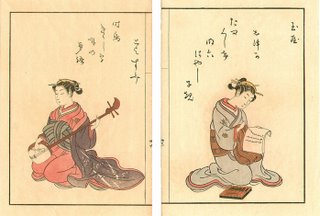 Shamisen and Letter by Harunobu 1. Spirituality
Experience your spirituality as a gift and a process.
2. Compliments
Don’t shrug off compliments; honor and remember them.
3. Experiences
Invest in experiences, not just objects.
4. Grace
Try doing even the most menial tasks mindfully and with grace.
5. Compassion
Anger has a way of evaporating in the face of compassion.
6. Calm
Calm is a place you create in the midst of chaos.
7. Simplicity
There’s no substitute for simple pleasures.
8. Laughter
Laugh a little — every day.
9. Physical
The spiritual and the physical cannot be separated; you need one to experience the other.
10. Pleasure
Find pleasure in the simplest tasks.
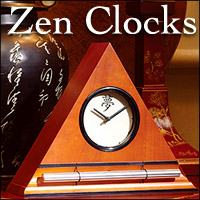 Zen Clocks with Chime from Boulder, CO adapted from Body + Soul Magazine, 2009
Now & Zen – The Zen Alarm Clock Shop
1638 Pearl Street
Boulder, CO 80302
(800) 779-6383
Posted in Meditation Timers, Meditation Tools, mindfulness practice, Well-being
 Mantra Meditation: Utamaro Kitagawa, The Courtesan Hanaogi of Ogiya Mantra Meditation
What is it?
Mantra meditation utilizes the power of sound and vibration to create stillness in the body, calm the nervous system and ultimately transform the mind. The words typically come from ancient spiritual languages, such as Sanskrit or Gurumukhi. The sacred meanings of the words enable you to establish a connection to profound truths that have been spoken for thousands of years, explains Krishna Kaur, a kundalini yoga teacher since 1970 and founding member of the International Association of Black Yoga Teachers (blackyogateachers.com).
What’s it good for?
Because each mantra differs in its meaning and vibrations produced, you can select mantras to create specific effects— such as increasing mental clarity, developing intuition, or reducing anger and stress. Kaur suggests starting with the simple mantra sat nam because it’s easy to say and remember, yet offers profound effects. Sat translates as “truth,” and nam as “identity.” This mantra helps you identify with a universal spiritual truth in which such transient emotional states as fear, anger and doubt fall away.
How long does it take?
Start with three to five minutes, increasing by a minute at a time until you can sit and chant for a full 11 minutes.
 Meditation How do I do it?
1. Sit comfortably in a chair or on the floor with your spine straight to help your breath and the sound it creates flow smoothly. Close your eyes and bring your attention to your breath for a moment to get centered.
2. Take a long, deep inhalation through your nose. As you exhale, utter an extended sat (pronounced “sut”) to almost the end of your breath, followed by a short burst of nam (“nom”). Together, the mantra will sound like “saaaaaaaaaaat nam.”
3. Inhale slowly and evenly, then repeat the mantra as you exhale. Continue this pattern.
4. At the end of your session, inhale and hold your breath for a few seconds, then exhale through your nose. Do this three times, then sit quietly for a moment and feel the energy flow through your body. Open your eyes, stand slowly and carry your sense of calm and clarity with you.
Although meditation can be done in almost any context, practitioners usually employ a quiet, tranquil space, a meditation cushion or bench, and some kind of timing device to time the meditation session. Ideally, the more these accoutrements can be integrated the better. Thus, it is conducive to a satisfying meditation practice to have a timer or clock that is tranquil and beautiful. Using a kitchen timer or beeper watch is less than ideal. And it was with these considerations in mind that we designed our digital Zen Alarm Clock and practice timer. This unique “Zen Clock” features a long-resonating acoustic chime that brings the meditation session to a gradual close, preserving the environment of stillness while also acting as an effective time signal. The Digital Zen Clock can be programmed to chime at the end of the meditation session or periodically throughout the session as a kind of sonic yantra. The beauty and functionality of the Zen Clock/Timer makes it a meditation tool that can actually help you “make time” for meditation in your life.
adapted from naturalhealthmag.com By Frances Lefkowitz
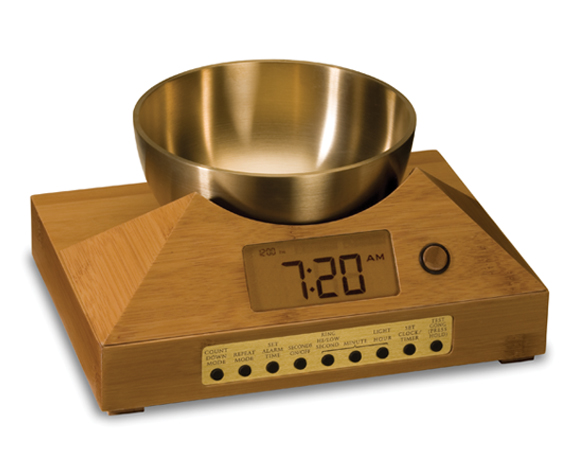 Bamboo Gong Meditation Timer and Alarm Clock Now & Zen, Inc.
1638 Pearl Street
Boulder, CO 80302
(800) 779-6383
Posted in Meditation Timers, Meditation Tools, mindfulness practice
 breathing exercises help relieve stress How simple breath work can lead you to a deep state of relaxation.
Beginning students often ask for instructions on the “right” way to breathe. Alas, there’s no single answer to that question, since the optimal breathing pattern at any given moment depends on the type of practice. Restorative yoga focuses solely on relaxation, though, and emphasizes breathing that creates calm and serene states of being. When you settle into restorative poses, try the following techniques for cultivating breathing patterns that are hallmarks of relaxation and well-being.
MOVE THE BELLY WITH THE BREATH. When we are at ease, the diaphragm is the primary engine of the breath. As we inhale, this domelike muscle descends toward the abdomen, displacing the abdominal muscles and gently swelling the belly. As we exhale, the diaphragm releases back toward the heart, enabling the belly to release toward the spine.
KEEP THE UPPER BODY QUIET. During high-stress times, it’s common to heave the upper chest and grip the muscles in the shoulders and throat. When we’re at rest, the muscles of the upper chest remain soft and relaxed as we breathe, and the real work occurs in the lower rib cage. To promote this type of breathing pattern, consciously relax the jaw, throat, neck, and shoulders, and envision the breath sweeping into the deepest parts of the lungs as you breathe in and out.
BREATHE EASY. Although some breaths may be deeper or faster than others, when we’re relaxed, the alternating rhythm of the inhalations and exhalations feels like a lullaby—smooth, soft, and uninterrupted by jerks and jags. Consciously relaxing into this wavelike, oceanic quality of the breath deepens our sense of peace and ease.
LENGTHEN THE EXHALATIONS. When we feel stressed, our exhalations tend to grow short and choppy. When we’re relaxed, though, the exhalations extend so completely that they are often longer than the inhalations. Some teachers even instruct that if we’re deeply relaxed, each exhalation will be twice as long as the inhalation. To facilitate this, try gently extending each exhalation by one or two seconds. Set your Bamboo Meditation Timer with Chime for 20 minutes and continue this exercise.
PAUSE AFTER EACH EXHALATION. In our most relaxed state, the end of each exhalation is punctuated by a short pause. Lingering in this sweet spot can be deeply satisfying and can evoke feelings of profound quiet and stillness.
LET THE WHOLE BODY BREATHE. When we are at ease, the whole body participates in the breathing process. Imagine a sleeping baby: When he breathes in and out, the belly swells and releases, the hips rock to and fro, the shoulders bob, and the spine gently undulates. This offers a mini-massage for the muscles and organs of the whole body, and turns each breath into a soothing melody that further calms and quiets every cell within.
adapted from Yoga Journal Magazine, by Claudia Cummins
Our Chime Meditation Clock & Timer’s long-resonating Tibetan bell-like chime makes waking up and meditation a beautiful experience – its progressive chimes begin your day with grace.
The Chime Meditation Clock & Timer serves as a countdown and interval timer for yoga, meditation, bodywork, etc.; and it can also be set to chime on the hour as a tool for “mindfulness.”
 Bamboo Meditation Timers with Soothing Chimes for Breathe Work Now & Zen’s Chime Timer and Alarm Clock Shop
1638 Pearl Street
Boulder, CO
(800) 779-6383
Posted in Meditation Timers, Meditation Tools, mindfulness practice, Well-being, yoga, Yoga Timer, Yoga Timers by Now & Zen, Zen Timers
 A Stillness Practice for before Bedtime Tailgaters. Telemarketers. Teenagers. When you can sum up your day that way, it’s easy to respond with a few choice words of your own. Yet losing your cool rarely feels good or reflects your best character. To maintain your center and stay true to yourself, try this technique from David Simon, M.D., medical director and co-founder of the Chopra Center for Well-Being in Carlsbad, Calif.
Every night before bed, take a few minutes to mentally replay your day. This simple process gives you a different perspective on your actions, along with the opportunity to right any wrongs.
* Set your Zen Timer with Chime for 5 to 10 minutes. Sit up in bed with a pillow propped behind you; bend your knees or cross your legs comfortably on the bed.
* Close your eyes and take a few slow, deep breaths. Observing the in-and-out flow of your breath, allow your body to relax and your mind to quiet.
* Let the day’s events unfold. Picture each one from the time you awoke to the present.
* Notice if your body reacts negatively during any part of the process. A churning in your gut or a nervous response may signal something unresolved.
* Reflect on this particular event and ask yourself if you acted correctly. If anything feels unsettled, note it in a journal with the intention of addressing it the next day.
Revisiting unresolved issues offers you a second chance to do the right thing, Simon says. Maybe a disparaging remark was said about someone you like and respect, but you didn’t speak up at the time. Now you can tell the person who made the remark why such talk makes you uncomfortable.
Over time, annoyances like traffic jams will seem less significant and stressful. “You’ll be able to stay centered and balanced as you encounter the ups and downs of life,” Simon observes. Even better, this nightly evaluation will make you more aware of your goals and how they relate to day-to-day activities. “It will help you honor the person you want to be in the world,” he says.
adapted from Natural Health Magazine by Sarah D. Smith
The Zen Timer & Alarm Clock with Chime serves as a countdown and interval timer for yoga, meditation, bodywork, etc.; and it can also be set to chime on the hour as a tool for “mindfulness.”
 Natural Wood Chime Zen Timers and Alarm Clocks Now & Zen’s Chime Alarm Clock Shop
1638 Pearl Street
Boulder, CO 80302
(800) 779-6386
Posted in intention, Meditation Timers, Meditation Tools, mindfulness practice, sleep, Well-being, Zen Timers
 What is a Walking Meditation Walking Meditation
What is it?
This component of numerous meditation traditions slows the walking process with the intention of bringing into awareness its most basic parts—lifting the foot, swinging it, placing it down—in order to bring a greater consciousness to daily life. When we break down the motion of walking, we realize how each action is a collection of sub-actions, and how the mind and body work together to create movement. “This is not walking for transportation, it’s walking as a tool for developing mindfulness in the present moment,” says John LeMunyon, L.M.T., co-owner of Heartwood Yoga in Birmingham, Ala., and a meditator for 30-plus years. You can practice walking meditation by itself, or combine it with one of the seated styles on the preceding pages. Used as an interlude, the walking technique is a good way to embody the insights gained during seated practice and to heighten their relevance in your daily life. Walking meditation shows clearly the Buddhist precept that “all action is preceded by intention,” says LeMunyon. “There’s always an intention; and when we are present to the moment, there is always a choice. It’s at the level of intention that we make our choices of how skillfully we want to live our lives.”
What’s it good for?
When you find yourself feeling restless or agitated, a physical practice like walking is a great way to quiet your mind and find grounding in your body. It can also help ease your transition from sitting meditation to the motion of “real life,” and vice versa.
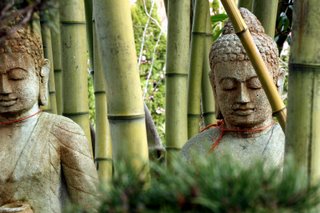 Walking Meditation How long does it take?
To begin, try walking for about 15 steps in two directions, about five minutes total. Or try interspersing this with five minutes of seated meditation.
How do I do it?
1. Find a private indoor or outdoor place with level ground and at least 20 feet of space to move.
2. Stand in a relaxed position with your feet parallel, shoulders loose, arms draped at your sides or clasped lightly in front of or behind you. Focus your eyes softly on the ground about 6 to 8 feet ahead (looking right at your feet can be distracting).
3. Breathe in as you lift your right heel. Pause and breathe out, leaving your toes resting on the ground.
4. Breathe in again as you slowly swing your right foot forward. Place the heel of your right foot on the ground as you exhale and roll the rest of the foot down, transferring your weight so it’s balanced between both feet. Pause for a full breath.
5. Repeat the entire sequence with your left foot, again matching each movement with an inhalation or exhalation, alternating for 15 steps. The goal is to keep your mind fully focused on your bodily sensations; it may help to think or softly say, “Lift, pause, swing, place, transfer, pause,” as you perform these movements.
6. When you’ve completed your paces in one direction, come to a stop with your feet parallel and pause for a few breaths. Then turn slowly, using the same movement pattern and matching each movement with an inhalation or exhalation. Pause again, facing the path you just walked. End by retracing your steps back to where you started.
adapted from naturalhealthmag.com By Frances Lefkowitz
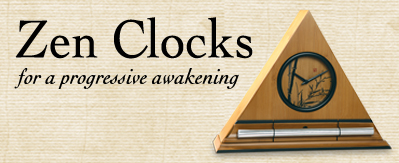 Zen Alarm Clocks and Meditation & Yoga Timers with Acoustic Sounds Now & Zen – The Chime Alarm Clock Store
1638 Pearl Street
Boulder, CO 80302
(800) 779-6383
Posted in Meditation Tools, Walking Meditation
 Meditation is a Quick Fix for Stress Meditating for just 20 minutes a day for five days helped to increase energy and decrease anxiety and stress, as measured by levels of stress hormones, a small study found.
Using the so-called integrative body-mind training method, which comes from traditional Chinese medicine, the study participants reported better attention and control of stress than those relying on relaxation training, which is popular in the West.
Although derived from Chinese medicine, integrative body-mind training uses aspects of other meditation and mindfulness training, the study authors said.
“A meditation method developed in China showed remarkably better performance among those who went through the training compared with those who used relaxation training,” said lead researcher Michael Posner, a psychology professor at the University of Oregon’s Institute of Cognitive and Decision Sciences.
In the study, published in this week’s issue of the Proceedings of the National Academy of Sciences, the researchers assigned 40 undergraduate students from China to either integrative meditation or relaxation therapy.
 Meditation Posner’s group found the students who used integrative meditation for 20 minutes a day for just five days showed greater improvement in conflict scores on a test of stress levels, lower anxiety, depression and anger. Conversely, they displayed more energy, less fatigue, a significant drop in levels of the stress hormone cortisol, and an increase in immunoreactivity, compared with students receiving the relaxation therapy.
Integrative body-mind training was developed in the 1990s, and has been studied in China since 1995. Based on the results from hundreds of adults and children ranging from 4 to 90 years old in China, the practice appears to improve emotional and cognitive performance and social behavior, the study authors said.
Because the study was done in China, Posner said he’s not sure if the same meditation method would work in the United States.
“This is a kind of scientific demonstration about the possible advantage of meditation, at least for the Chinese undergraduates,” Posner said. “It could be culturally specific.”
Posner does think, however, that the study shows it’s possible to change the levels of stress hormones with training.
More information
To learn more about meditation, visit the U.S. National Center for Complementary and Alternative Medicine.
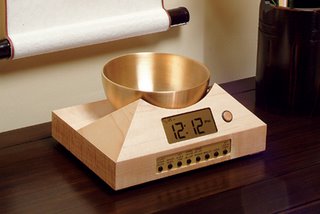 Once you experience the Zen Timepiece's progressive tones, you'll never want to meditate any other way. It serves as the perfect meditation timer. Now & Zen – The Gong Meditation Timer Shop
1638 Pearl Street
Boulder, CO 80302
(800) 779-6383
Posted in Meditation Timers, Meditation Tools, mindfulness practice
 Meditation - A Wellness Practice It’s nearly impossible to pay attention to one thing for a long time. A new study looks at whether Buddhist meditation can improve a person’s ability to be attentive and finds that meditation training helps people do better at focusing for a long time on a task that requires them to distinguish small differences between things they see.
The research was inspired by work on Buddhist monks, who spend years training in meditation. “You wonder if the mental skills, the calmness, the peace that they express, if those things are a result of their very intensive training or if they were just very special people to begin with,” says Katherine MacLean, who worked on the study as a graduate student at the University of California – Davis. Her co-advisor, Clifford Saron, did some research with monks decades ago and wanted to study meditation by putting volunteers through intensive training and seeing how it changes their mental abilities.
About 140 people applied to participate; they heard about it via word of mouth and advertisements in Buddhist-themed magazines. Sixty were selected for the study. A group of thirty people went on a meditation retreat while the second group waited their turn; that meant the second group served as a control for the first group. All of the participants had been on at least three five-to-ten day meditation retreats before, so they weren’t new to the practice. They studied meditation for three months at a retreat in Colorado with B. Alan Wallace, one of the study’s co-authors and a meditation teacher and Buddhist scholar.
 Meditation for Wellness The people took part in several experiments; results from one are published in Psychological Science, a journal of the Association for Psychological Science. At three points during the retreat, each participant took a test on a computer to measure how well they could make fine visual distinctions and sustain visual attention. They watched a screen intently as lines flashed on it; most were of the same length, but every now and then a shorter one would appear, and the volunteer had to click the mouse in response.
Participants got better at discriminating the short lines as the training went on. This improvement in perception made it easier to sustain attention, so they also improved their task performance over a long period of time. This improvement persisted five months after the retreat, particularly for people who continued to meditate every day.
The task lasted 30 minutes and was very demanding. “Because this task is so boring and yet is also very neutral, it’s kind of a perfect index of meditation training,” says MacLean. “People may think meditation is something that makes you feel good and going on a meditation retreat is like going on vacation, and you get to be at peace with yourself. That’s what people think until they try it. Then you realize how challenging it is to just sit and observe something without being distracted.”
This experiment is one of many that were done by Saron, MacLean and a team of nearly 30 researchers with the same group of participants. It’s the most comprehensive study of intensive meditation to date, using methods drawn from fields as diverse as molecular biology, neuroscience, and anthropology. Future analyses of these same volunteers will look at other mental abilities, such as how well people can regulate their emotions and their general well-being.
By Keri Chiodo, Association for Psychological Science
Now & Zen – The Gong Meditation Timer Shop
1638 Pearl Street
Boulder, CO 80302
(800) 779-6383
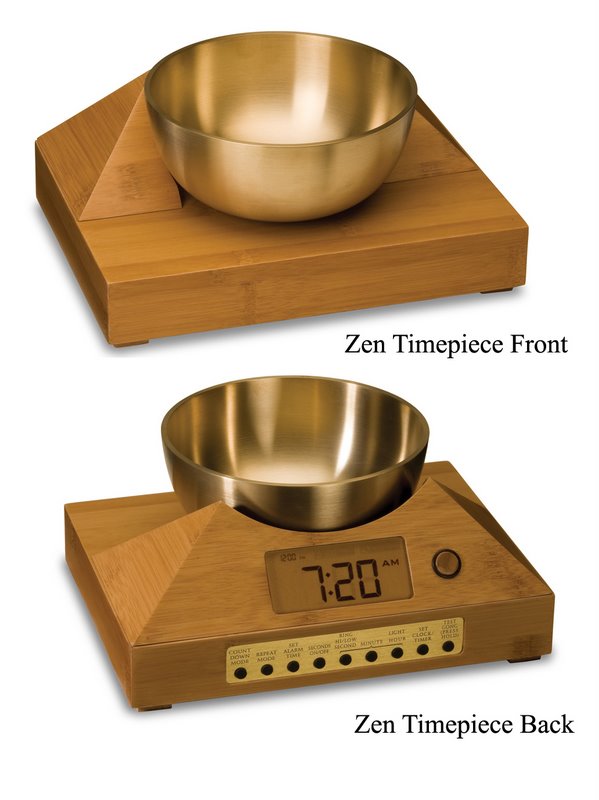 Gong Meditation Timer for Your Wellness Practice
Posted in Meditation Tools
 Meditation and Yoga Researchers say they’ve taken a significant stride forward in understanding how relaxation techniques such as meditation, prayer and yoga improve health: by changing patterns of gene activity that affect how the body responds to stress.
The changes were seen both in long-term practitioners and in newer recruits, the scientists said.
“It’s not all in your head,” said Dr. Herbert Benson, president emeritus of the Benson-Henry Institute for Mind/Body Medicine at Massachusetts General Hospital and an associate professor of medicine at Harvard Medical School. “What we have found is that when you evoke the relaxation response, the very genes that are turned on or off by stress are turned the other way. The mind can actively turn on and turn off genes. The mind is not separated from the body.”
One outside expert agreed.
“It’s sort of like reverse thinking: If you can wreak havoc on yourself with lifestyle choices, for example, [in a way that] causes expression of latent genetic manifestations in the negative, then the reverse should hold true,” said Dr. Gerry Leisman, director of the F.R. Carrick Institute for Clinical Ergonomics, Rehabilitation and Applied Neuroscience at Leeds Metropolitan University in the U.K.
“Biology is not entirely our destiny, so while there are things that give us risk factors, there’s a lot of ‘wiggle’ in this,” added Leisman, who is also a professor at the University of Haifa in Israel. “This paper is pointing that there is a technique that allows us to play with the wiggle.”
 Meditation and Yoga Reduce Stress Benson, a pioneer in the field of mind-body medicine, is co-senior author of the new study, which is published in the journal PLoS One.
Benson first described the relaxation response 35 years ago. Mind-body approaches that elicit the response include meditation, repetitive prayer, yoga, tai chi, breathing exercises, progressive muscle relaxation, biofeedback, guided imagery and Qi Gong.
“Previously, we had noted that there were scores of diseases that could be treated by eliciting the relaxation response — everything from different kinds of pain, infertility, rheumatoid arthritis, insomnia,” Benson said.
He believes that this study is the first comprehensive look at how mind states can affect gene expression. It also focuses on gene activity in healthy individuals.
Benson and his colleagues compared gene-expression patterns in 19 long-term practitioners, 19 healthy controls and 20 newcomers who underwent eight weeks of relaxation-response training.
More than 2,200 genes were activated differently in the long-time practitioners relative to the controls and 1,561 genes in the short-timers compared to the long-time practitioners. Some 433 of the differently activated genes were shared among short-term and long-term practitioners.
Further genetic analysis revealed changes in cellular metabolism, response to oxidative stress and other processes in both short- and long-term practitioners. All of these processes may contribute to cellular damage stemming from chronic stress.
Another expert had a mixed response to the findings.
Robert Schwartz, director of the Texas A&M Health Science Center’s Institute of Biosciences and Technology in Houston, noted that the study was relatively small. He also wished that there had been more data on the levels of stress hormones within the control group, for comparison purposes.
However, Schwartz called the study “unique and very exciting. It demonstrates that all these techniques of relaxation response have a biofeedback mechanism that alters gene expression.”
He pointed out that the researchers looked at blood cells, which consist largely of immune cells. “You’re getting the response most probably in the immune cell population,” Schwartz said.
“We all are under stress and have many manifestations of that stress,” Benson added. “To adequately protect ourselves against stress, we should use an approach and a technique that we believe evokes the relaxation response 20 minutes, once a day.”
Use our unique “Zen Clock” which functions as a Yoga & Meditation Timer. It features a long-resonating acoustic chime that brings your meditation or yoga session to a gradual close, preserving the environment of stillness while also acting as an effective time signal. Our Yoga Timer & Clock can be programmed to chime at the end of the meditation or yoga session or periodically throughout the session as a kind of sonic yantra. The beauty and functionality of the Zen Clock/Timer makes it a meditation tool that can actually help you “make time” for meditation in your life. Bring yourself back to balance.
There’s more on meditation at the U.S. National Center for Complementary and Alternative Medicine.
 Yoga and Meditation Timers with Chime Now & Zen – The Yoga and Meditation Timer Shop
1638 Pearl Street
Boulder, CO 80302
(800) 779-6383
Posted in Meditation Timers, Meditation Tools, mindfulness practice
 What is a Listening Meditation? Listening Meditation
What is it?
While many meditation techniques require solitude and silence, this one has you engage with sounds all around you; it invites you to work with the noise instead of fighting it. The intent is to experience sound as vibration, rather than information. “The listening practice is a way of interacting with the environment that allows you to take in the whole energy of the present moment,” says Sally Kempton, a spiritual guide who teaches yoga and meditation at her Carmel, Calif.- based Awakened Heart Meditation (sallykempton.com).
 What is a Listening Meditation Good For? What’s it good for?
Especially adaptable and portable, listening meditation can be practiced in crowded, noisy situations—on a bus, at the office—that would hinder other styles. (Kempton once led a listening meditation workshop in the middle of a busy Whole Foods store!) People with particularly chattering minds may need to couple this practice with a mantra or breathing meditation. However, many people welcome the chance to focus outward rather than inward and find that listening meditation is one of the easier techniques to undertake. “You’ll come away from it feeling refreshed, expanded and at ease with your environment,” declares Kempton.
How long does it take?
Try for five minutes at first, then continue adding a minute or two until you can do it for 15 or 20 minutes at a time.
How do I do it?
1. Sit in a comfortable position and close (or half close) your eyes.
2. To get centered and quiet, first go to your breath, noticing but not trying to change it.
3. Now “open” your ears and bring your awareness to the sounds around you. The goal is to listen to the whole range of sounds, without favoring one and without identifying them. Hear the quiet sounds and the silences as well as the dominant sounds.
4. When you find yourself identifying sounds (“there’s a fire engine”; “that’s my neighbor’s TV”), gently redirect your attention from listening to a specific noise back to hearing the whole spectrum of sounds.
5. To end, slowly open your eyes, stand and carry this awareness with you for as long as you can.
adapted from naturalhealthmag.com By Frances Lefkowitz
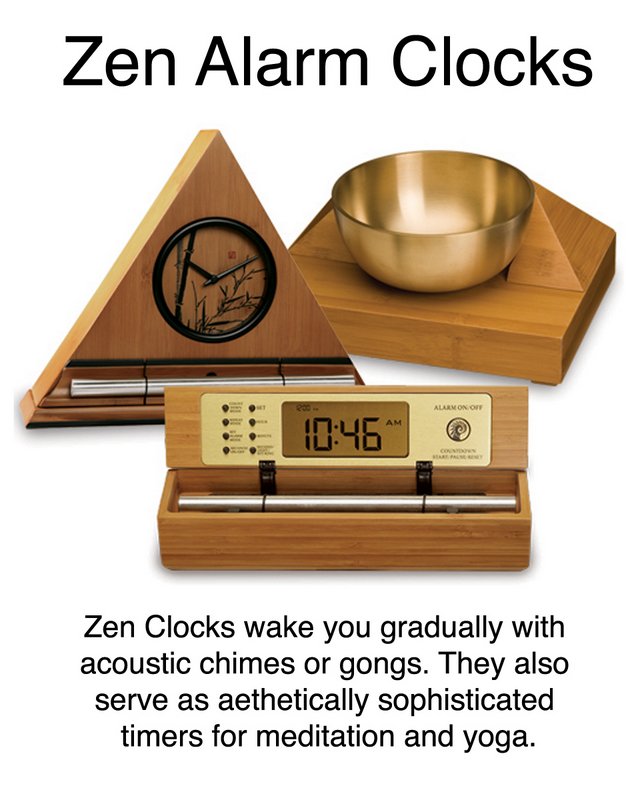 Gong Meditation Timers for a Listening Meditation Now & Zen – The Gong Meditation Timer Shop
1638 Pearl Street
Boulder, CO 80302
(800) 779-6383
Posted in Meditation Timers, Meditation Tools, mindfulness practice
« Previous Page — « Previous Entries
Next Entries » — Next Page »
|
|
|
|